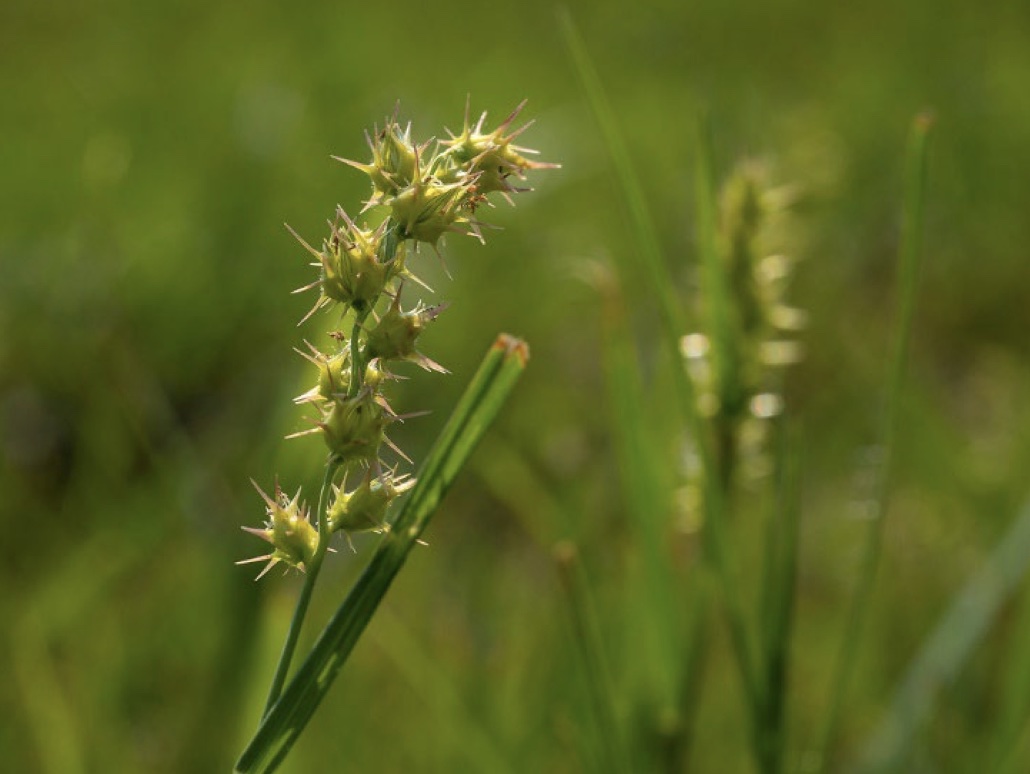Ag Insights March 2023
Wednesday, March 1, 2023
Sandbur Control
Josh Bushong, West Area Extension Crops Specialist
Sandburs are a common weed issue found in pastures, forage crops, and lawns. As the name implies, sandburs are typically more of an issue in sandy soils. Sandburs are an annual warm season grass, but with a mild winter can behave as a short-lived perennial. Seeds can germinate all summer, but most will germinate in May and June. Sandburs can obviously be an issue with livestock in pastures and hay production, but can also reduce forage quality and quantity. Since sandbur seeds can stay viable in the soil for 5 to 8 years, the main objective for suppression would be reducing seed development. Control will take several years of intensive management utilizing both cultural practices and herbicides.
Proper weed management starts with taking care of the soil, which starts with taking a soil sample. In order to give the desired crops a completive chance, soil pH and nutrient deficiencies will need to be corrected. Sandburs have more tolerant to acidic (low pH) soils than many warm season forages. Of the nutrients, applying adequate nitrogen will be the most beneficial to improve the stand of the desired forage. Correcting phosphorus and potassium will also help improve root development and plant regrowth. In addition to soil fertilization, other cultural suppression practices include stocking rate and burning. Proper stocking rates should be managed to retain adequate biomass for the crop to regrow at a faster pace and stay completive with sandburs. For Bermudagrass, leaving 2 to 3 inches is essential for good regrowth for both haying and grazing.
Pasture burning can reduce sandbur seed production if executed at the right time and intensity. Fall burns will likely be better, unless there is sufficient fuel for a hot spring burn. If the fire from the burn is not hot enough, it may actually stimulate germination. At first one would think that would be a bad thing, but could also allow for better control long-term. After the burn a higher percentage will emerge the first year, which an herbicide would effectively control a larger percentage of the sandbur population in one application.
There are a few herbicides that can be used to assist in sandbur control. Unfortunately, most are only labeled in bermudagrass. There are no herbicides labeled for sandbur control in Old World Bluestem, crabgrass, and some native grasses. In most native grass pastures, herbicides with the active ingredient imazepic (Plateau, Panoramic, or Impose) will provide some control but will also cause some damage to the native grasses. This injury is often temporary and lessened if good growing conditions follow herbicide application.
For bermudagrass pasture and hay fields, the use of a preemergence (applied before sandburs germinate) herbicide like pendimethalin (Prowl H2O) will help reduce half to two-thirds of the largest and earliest flush of sandburs. Postemergence (applied after bermudagrass and sandburs are actively growing) herbicide options include glyphosate (Roundup Weathermax), imazepic (Plateau), or nicosulfuron with metsulfuron (Pastura). Read and follow label directions for rates, application timings, and surfactants to limit crop injury and to achieve satisfactory sandbur control.
Lack of control is usually due to herbicide application timing. Sandbur growth stage is critical for some products. For instance, after sandburs reach 1.5 inches tall the expected control will be reduced with products like Pastora. If applied correctly, over 90 percent of the sandburs can be controlled with the postemergence herbicides. Keep in mind, sandburs will continue to emerge as the season progresses which may make it appear like the early herbicide application failed.
A newer product now available, called Rezilon, gives farmers another preemergent herbicide option. It is recommended to be applied well before sandbur germination. Ideally it should be applied late-winter, but can also be applied mid-season generally after the first cutting to prevent late-season emergence.
Herbicide products like MSMA are good options for lawns, golf courses, sod farms, and highway right-of-ways, but cannot be applied to pastures or hay ground. This is mostly due to the risk of poisoning livestock from being an arsenic-based herbicide.
A multi-year strategy of combining cultural suppression practices and herbicides is necessary. For more information refer to OSU factsheet PSS-2596 Sandbur Control in Bermudagrass Pastures or visit your local OSU Extension office.
Consider Longevity During Heifer Development
Dana Zook, West Area Extension Livestock Specialist
This is an interesting time in the cattle industry. High feed costs paired with a multi-year drought have been a tough set of circumstances for cattle producers to deal with. Despite high inputs, some producers are retaining heifers and the expense of development could be very high. This is more reason to develop a heifer that will have longevity and will remain in the herd long term. Let’s take a few moments and talk about longevity in the cow herd.
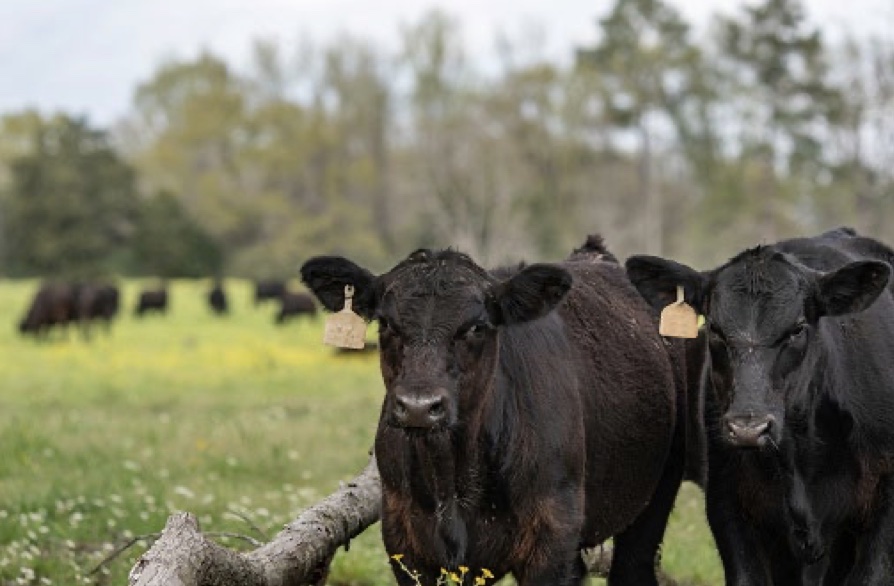
Longevity is impacted by culling. Cows are culled for many things including temperament, structural issues, age, teeth, etc. According to the 2017 NAHMS Study, approximately 64% of the time, the reason for culling a cow (in ranches with 50+ cows) was due to pregnancy status. This would include cows that were open or had aborted a calf.
Longevity is impacted by long term reproductive health. Another interesting study out of the University of California-Davis (Renquist et al. 2006) looked at the natural impacts of age on a cow. These researchers evaluated 454 fall-calving British-cross cows 3 to 10 years of age and assessed the associations of age with body condition score (BCS) and production parameters. Within this study, 3-year-old cows had the lowest body weight and BCS and 8-year-old cows had the greatest. Interestingly, pregnancy rate averaged around 80% in cows up to 9 years of age but decreased to an average of 57% in 10- year-old cows.
Longevity increases when cows fit their environment. Many producers would say their old cows (10+ years) are equally productive to their young cows. I do agree that older cows add important value to a producer’s herd. If a cow makes it ten years without losing a calf, we can assume she is well adapted to her production environment. Culling a cow simply because she is 10 is a matter of choice. However, the previous data set explains while some females remain productive to old age, there is greater chance of reproductive failure after 10 years of age.
So what can be done to increase longevity of a cow herd? I think the question can be traced in part back to the very beginning when we develop our breeding heifers. Are heifers developed with and adapted to the resources available? Researchers at the University of Nebraska and at the USDA-ARS Range Research Lab in Miles City, Montana, contest that the theory of feeding heifers and cows to a set body weight or BCS, “without consideration of the environmental abundance of associated resources”, is setting animals up for potential reproductive failure when feed resources are short. This is the idea that falsely altering an environment during heifer development to assure reproductive success may actually be reducing longevity.
Many organizations (including myself!) have promoted feeding heifers to 55-65% of mature weight in any way possible. This would include dry lot development and/or high energy rations that increase weight gain. Is this how our future cow herd will operate? My guess is that few producers plan to drylot their cow’s long term. For this reason, producers should consider development strategies that adapt heifers to their future grazing environment. In this time of high feed prices, consider your development strategy, cost, and available resources. Is there enough forage or grass to provide a good nutritional foundation for development? The current forage situation is dire and even if the rains come this spring, pastures need time to recover. I hope this article gives producers some things to think about as they develop their heifers this spring and summer. Stay tuned for my next article that will outline tips for replacement heifer development.
2023 Hay Outlook
Trent Milacek, West Area Extension Ag Econ Specialist
I have to apologize for exposing fresh wounds, but the prospect of feeding cattle in the winter of 2023/24 begins this spring. Many producers are still scrambling for hay supplies as most reserves have been depleted. Fortunately, recent moisture in some areas of the state give promise for spring grass.
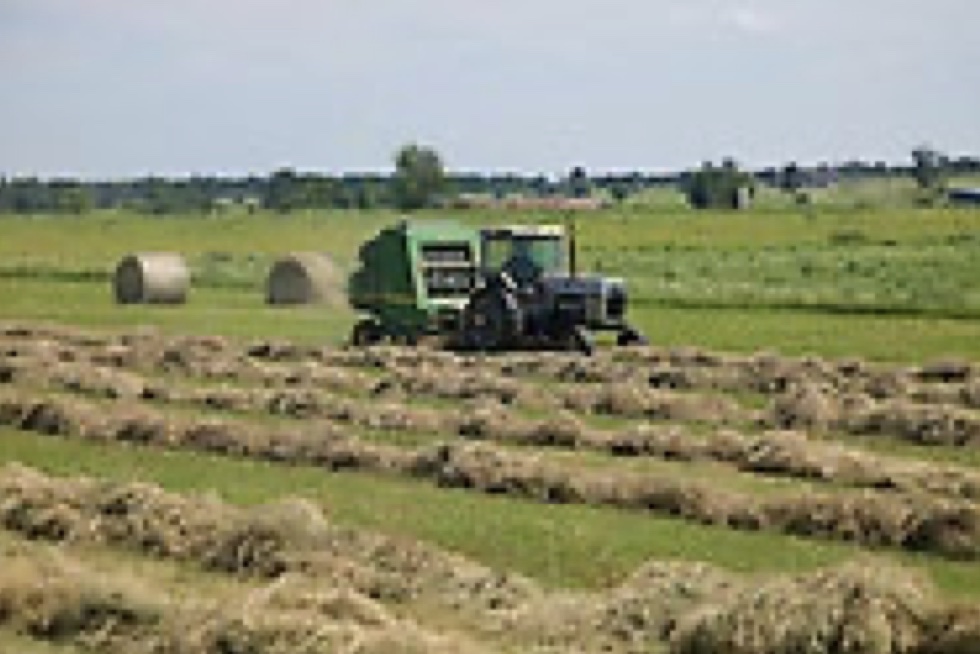
The current drought is one of the most extreme in recent memory. Some may recollect that there were periods of less rainfall or higher temps, but this drought has been long lasting and widespread across the entire United States. This widespread effect has lessened the ability for nearby regions to ship hay to us and overall hay supplies are lower than they have been in recent drought years.
Will producers be eager to replenish hay stocks in 2023? Some I have talked to believe they will wait to see what the summer offers. With 5x6 round bales bringing well over $100/bale I am not surprised. However, there have been many acres of oats planted and early season moisture makes producers hopeful for good haying. opportunities. If you want to carry a large cow herd into next year, be mindful of securing hay supplies when you can.
Another consideration is the demand for hay. While hay supplies are very low, we have also sold off a large portion of the cow herd. There will be less mouths to feed and that could certainly dampen the insatiable need for hay in the coming year. I know several producers who have had to sell cows even though they fed through the winter. They just came up a few months short of having enough hay.
I am not optimistic about the availability of hay coming into Oklahoma from nearby states in the coming year. All of the surrounding states suffered as we have, and it will take high moisture events to replenish soil reserves. Also keep in mind that many pastures have been overgrazed in the past year so early season forage is likely to suffer as plants replenish root reserves. That of course is entirely dependent on continued rainfall as we ponder this problem in February.
As I plan for the coming year there are some things I want to do differently. Consider spraying weeds early to reduce the competition for moisture. Early season moisture reserves will be incredibly important as we try to recover from the drought. I also believe it is a good idea to consider fertilizing improved grasses in a more strategic way. Get soil samples so that you know where your grass stands are at. If we have reduced root mass in the drought, access to phosphorus and other nutrients such as potassium could be limited. If you have not fertilized in recent years, those plants may be dependent on deep root mass to access enough of those nutrients.
Long-range weather forecasts have me hopeful that we will move out of a La Nina pattern. That does not necessarily mean we will see average or above average rainfall. Continue to weigh the cost and benefit of keeping high stocking rates to the promise of higher calf prices in coming years. It can pay to be counter cyclical if you have the resources to accomplish it. Just be sure you don’t burn up reserves to keep cows that will end up getting sold in January anyway.
Cattle Management During the Breeding Season
Britt Hicks, Ph.D., Area Extension Livestock Specialist
The spring breeding season is drawing near and producers need to properly manage both their cows and bulls considering ways to optimize beef production. Herd reproduction and fertility are important for profitability to occur. Research has shown that the economic value of reproduction is 5 times greater than growth or maternal output traits in beef cattle (Mulliniks et al., 2019). Hence, getting cows bred in a timely manner is critical. Open cows negatively impact profitability, so producers need to use breeding programs that increase the percentage of their cows that get bred. A successful breeding season hinges on nutrition, vaccination, sire selection, breeding soundness exams, and management protocols to control the length of the breeding season.
The first step in preparing the herd for the breeding season is to assess the nutritional status of both cows and bulls. Body condition scoring (BCS) is a practical management tool to allow beef producers to distinguish differences in nutritional needs of animals in the herd. A cow should calve at a BCS of 5 to 6 and be bred at a BCS of 5 to 6. Ifa cow calves at a BCS less than 5 it will take her longer to return to estrus and thus, take longer to get her rebred.
A BCS of 5 to 6 for bulls is also recommended before the breeding season starts since bulls being too fat or too thin can impact fertility. If changes need to be made to the diet to achieve this BCS they should occur gradually. Ration changes prior to the breeding season can have effects on reproductive performance because mature sperm is produced over a 60-day period before ejaculation. During the breeding season producers should assess the BCS of the bull. It is not unusual for a bull to lose 100 to 200 lb. during the breeding season. If the bull becomes too thin the producer should consider replacing him because his ability to breed cows will be reduced. After the breeding season adequate nutrition is needed to help the bull regain the weight lost.
It is recommended that breeding soundness exams be conducted on all bulls a few weeks before the breeding season even if they were recently purchased as "satisfactory breeders" as a good insurance policy. In addition to breeding soundness exams, pre- breeding vaccinations is an important practice. A visit with your veterinarian about appropriate vaccinations, deworming, and other health considerations is recommended.
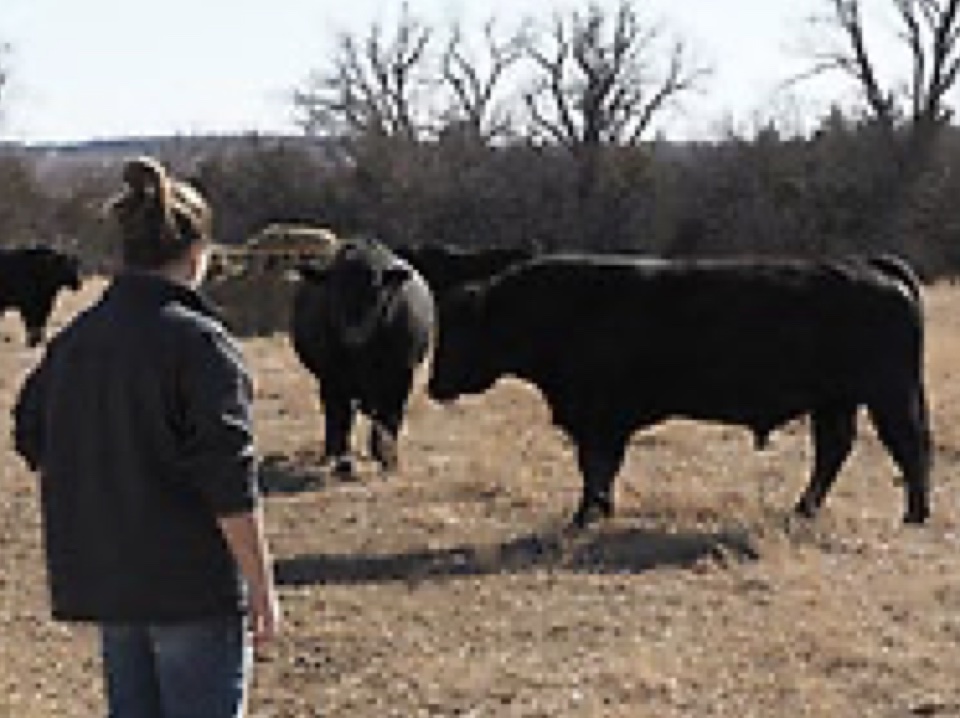
Even if bulls have a proper BCS, have had adequate exercise, and have been with the other herd bulls to determine social dominance, ranchers need to continually observe and manage bulls. Young bulls have great potential to bring genetic improvement to your herd, however they will experience an acclimation period prior to breeding any females. In order to start calving on your selected date, it may be important to turn young bulls out a few days early, so they can get adjusted to their environment and be ready to breed cows when you would like them to start. Managing young bulls will be more challenging because they are still growing. Since they have higher nutrient requirements, they will likely lose condition faster than mature bulls.
Social dominance in pastures can also be a concern. Yearling bulls and older, mature bulls should be in separate pastures. If they are together, the yearlings cannot compete with the older bulls thus, resulting in limited genetic improvement, as well as possible injury to the younger bulls. If older bulls have been used more than two breeding seasons, they have a tendency to become territorial and may spend more time fighting and defending their territory than servicing cows. This is a situation where observation is key because bulls may not be getting the cows bred or could be injured or causing injuries. If you are observing animals closely, bulls that are either injured or lack desire can be removed.
Another important issue to address is how many bulls to put in each pasture. A rule of thumb is one cow per month of age of the bull up to 3 years old. Therefore, the true “yearling” would only be exposed to 12 or 13 females. If he is a year and a half old (18 months), then he should be able to breed 15 – 18 cows. By the time the bull is two years of age, he should be able to breed 24 or 25 cows. However, research indicates this number could be increased to as many as 50 cows per bull without a negative impact on conception rate. In determining the proper bull power, several factors should be considered including the topography and size of the pasture, feed condition, age and condition of the bulls.
Producers need to continually observe and manage both bulls and cows during the breeding season. Overlooking critical warning signs could result in reduced pregnancy rates. Assess the BCS of the bulls. It is not unusual for a bull to lose 10 to 15% of their body weight during the breeding season. If the bull becomes too thin the producer should consider replacing him because his ability to breed cows will be reduced. Observe bulls to ensure they are actively checking cows and breeding normally. Watch for injuries. Multiple cows coming back into heat after being bred or a high number of cows showing heat late in the breeding season are also important warning signs.
In conclusion, a successful breeding season is not only dependent on the BCS of the cows but also on the success of the bulls. Bulls have more influence on the success of the breeding season and the herd’s future genetics because a cow produces one calf a year, while a bull can potentially sire 25 to 50 calves annually. Breeding success is vitally important to the profitability of the beef operation. Through good management practices breeding efficiency can be obtained. It is important to remember that both the cow and the bull are vital parts to the breeding equation.
Purchasing Chicks and Hens
Barry Whitworth, DVM, Senior Extension Specialist, Department of Animal and Food Sciences
Although egg prices have been trending down, some individuals have been tempted to buy some chicks/hens and begin producing eggs at home. According to the United States Department of Agriculture, backyard poultry production is a popular agriculture enterprise with egg-laying breeds the most popular type of chicken raised. Before purchasing any chicks/hens, individuals need to do their research. Questions related to housing, breed, health, biosecurity, and city codes are just a few issues that backyard poultry producers need to consider.
Although backyard poultry production is very popular in the United States, some urban areas may not be receptive to chickens in the backyard. Before purchasing any chicks, producers need to check with local authorities about restrictions and regulations regarding backyard poultry production. Once a producer understands all the city rules and regulation, they will need to choose a breed. Not all chickens are alike. Certain breeds are more suited for certain environments. Some are more heat tolerant, and some tolerate the cold better. Some breeds lay larger numbers of eggs than others, and certain breeds lay different colored eggs. Producers should consult with fellow poultry producers and check resources online for the best breed for their operation.
Housing is the costliest expenditure with backyard chickens. The housing needs to provide adequate space for each bird. Recommendations for indoor space is 4 square feet per bird. The housing should provide protection from weather events as well as predators. Indoor housing needs to be well ventilated to prevent issues with respiratory disease. Lastly, if living in an urban area, the housing needs “curb appeal” to keep the neighbors happy.
If producers expect plenty of eggs for the table, keeping chickens healthy will be important. In a review of the most common causes of death in backyard poultry in the United States, Dr. Cadmus and associates found cancer, bacteria, viruses, and parasites were all common causes of health issues in backyard poultry. Cancer is the most common cause of death in backyard poultry with 41% of all dead birds submitted for necropsy diagnosed with some form of cancer. Marek’s disease was the most common cause of the cancers. Producers should remember that diseases in poultry are much easier to prevent than treat.
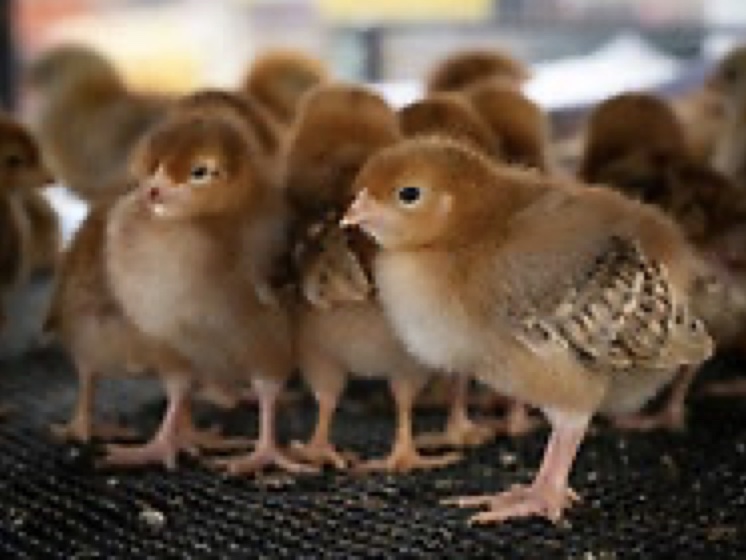 One-way producers can avoid diseases in their flocks is to start with healthy chicks.
To find healthy chicks, producers should purchase birds from a National Poultry Improvement
Plan (NPIP) certified hatchery. The NPIP was initially started in the 1930s to eliminate
Salmonella pullorum from chicks which was highly fatal. Today, NPIP hatcheries monitor
and test for a variety of diseases. Purchasing chicks from a NPIP flock will not prevent
every disease but it should provide confidence that the chicks are coming from a healthy
flock.
One-way producers can avoid diseases in their flocks is to start with healthy chicks.
To find healthy chicks, producers should purchase birds from a National Poultry Improvement
Plan (NPIP) certified hatchery. The NPIP was initially started in the 1930s to eliminate
Salmonella pullorum from chicks which was highly fatal. Today, NPIP hatcheries monitor
and test for a variety of diseases. Purchasing chicks from a NPIP flock will not prevent
every disease but it should provide confidence that the chicks are coming from a healthy
flock.
In addition to purchasing chicks from a NPIP flock, chicks should be vaccinated for certain diseases early in life. As mentioned earlier, Marek’s disease is one of the leading causes of death in backyard chickens. The disease can be easily prevented by vaccinating the chicks on day 1 or in ovum prior to hatching. Most hatcheries will provide this service for a small fee. Consult with a poultry specialist and/or a veterinarian for other diseases that can be prevented with vaccinations.
Although parasites in Dr. Cadmus review did not account for a high number of deaths, routine monitoring of parasites is a good habit. Coccidia, which was the most common parasite found to cause fatalities, damages the intestine which results in digestive problems. To combat this parasite, chicks should be placed on a coccidiostat which is usually administered in the water or feed. There are a few different coccidiostats available, so consult with a poultry specialist and/or veterinarian for the best option.
Of all disease prevention options available to backyard poultry producers, biosecurity is the best. Biosecurity is a series of management practices designed to prevent the introduction and spread of disease agents on a poultry operation. Backyard poultry producers can find information on biosecurity at http://healthybirds.aphis.usda.gov. Also, Oklahoma State University Cooperative Extension has an excellent fact sheet Small Flock Biosecurity for Prevention of Avian Influenza ANSI-8301 which can be obtained at the local OSU County Extension office or at https://extension.okstate.edu/fact- sheets/small-flock-biosecurity-for-prevention-of-avian-influenza.html.
Lastly, backyard poultry producers may not be aware of the dangers that poultry can have on human health. Since birds usually do not show any clinical signs of being ill, they shed organisms in their feces and other bodily fluids without producers realizing they are endangered. Several of the pathogens that infect poultry can also infect humans. Every year the Center for Disease Control and Prevention (CDC) investigates Salmonella infections in humans associated with backyard poultry. In 2022 there were 1,230 cases of Salmonella infections in people in 49 states. Two hundred twenty-five people were hospitalized with the disease. Two deaths were reported. Twenty-one percent of the cases were in children under 5 years of age. In interviews, 59% of the sick people reported contact with chicks or ducklings. Oklahoma reported 17 cases of Salmonella infections. It should be kept in mind that the CDC believes that for every one Salmonella case reported many cases go unreported.
The best way people can protect themselves from developing infection s associated
with backyard poultry is to practice good hand hygiene. Producers should wash their
hands before and after having contact with their birds. Children under 5 years of
age need to be supervised when around poultry. This group needs to especially practice
good hand hygiene. 
Eating eggs from chickens in the backyard may
or may not save money but raising backyard chickens can be very rewarding. Before
purchasing any chicks, producers should become familiar with all aspects of backyard
poultry production. A good source of information is Oklahoma State University Extension
Backyard poultry course available at https://learn.extension.okstate.edu/courses/backyard-chickens. This interactive course provides information on poultry nutrition, health issues,
biosecurity practices, egg sales, and more.
References
Cadmus KJ, Mete A, Harris M, Anderson D, Davison S, Sato Y, Helm J, Boger L, Odani
J, Ficken MD, Pabilonia KL. Causes of mortality in backyard poultry in eight states
in the United States. J Vet Diagn Invest. 2019 May;31(3):318-326.
Centers for Disease Control and Prevention. (2022). Outbreaks of Salmonella Infections Linked to Backyard Poultry. Atlanta, GA: US Department of Health and Human Services. Retrieved from: https://www.cdc.gov/salmonella/outbreak.html
Jacquie, Jacob. (February 21, 2023). Getting started with small and backyard poultry. Extension. https://poultry.extension.org
How Does Extended Wheat Stocker Grazing Impact Economic Returns?
Eric A. DeVuyst, Agricultural Economics Professor and Rainbolt Chair Roger Sahs, Associate Extension Specialist, Department of Agricultural Economics
With hay supplies extraordinarily tight in Oklahoma and winter still here, both wheat stocker producers and cow-calf producers are looking for forage sources to get by until stockers are sold or grass greens up for grazing. One temptation is to continue grazing dual-purpose wheat later than is recommended by Oklahoma Cooperative Extension Service personnel. This is a temptation to be resisted!
Past research demonstrates significant economic losses from grazing winter wheat 
past the physiological growth phase called first hollow stem. Depending on weather
and location, first hollow stem usually appears around March 1 but in warm winters
it occurs in February. Fieser et al. reported a 1% loss in wheat grain yield from
grazing just one day past first hollow stem. Even at that seemingly harmless loss,
DeVuyst et al. show losses of about $1 per acre net of cattle gain and wheat grain
loss. However, Fieser et al. evaluated losses on stockpiled wheat forage, a rather
uncommon management practice in Oklahoma. Alternatively, Redmon et al. evaluated losses
from more conventionally managed wheat grazing. Their results show a 5% average loss
in wheat grain yield from just one day of extended grazing. DeVuyst et al. report
that equates to over $11 per acre in lost net returns after considering the value
of cattle gains and wheat grain losses.
Grazing for seven days past first hollow stem has substantially worse economic outcomes. Grain yield reductions range from 6% (Fieser et al.) to 33% (Redmon et al.). Using these estimates of grain yield loss, DeVuyst et al. report economic losses ranging from almost $4 to $75 per acre. Taylor et al. combined the two datasets and report wheat grain loss of 18% with a resulting economic loss of $35 per acre (DeVuyst et al.).
Regardless of prior management, the data clearly show that grazing past first hollow set is not economically advisable. Added cattle gains do not justify lost wheat grain yield. Producers are encouraged to check wheat frequently as temperatures warm and wheat is actively growing to avoid extended grazing.
References
DeVuyst, E.A., R. Sahs, K.W. Taylor, F.M. Epplin, G.W. Horn, and J.T. Edwards. 2023.
“The Effect of Extended Stocker Grazing on Wheat and Stocker Profits” Oklahoma State
University Cooperative Extension Service. Pending.
Fieser, B.G., G.W. Horn, J.T. Edwards, and E.G. Krenzer, Jr. “Timing of Grazing Termination in Dual-Purpose Winter Wheat Enterprises.” The Professional Animal Scientist 22(2006):210-216.
Redmon, L.A., E.G. Krenzer Jr., D.J. Bernardo, and G.W. Horn. “Effect of Wheat Morphological
Stage at Grazing Termination on Economic Return.” Agronomy Journal 88(1996):94-97.
Extension Experience – Insights into Oklahoma Agriculture
The Northwest Area Extension Staff would like to announce the creation of our new podcast Extension Experience. The Extension Experience podcast is brought to you by Josh Bushong, Trent Milacek, and Dana Zook. Each week they provide perspective on Agriculture topics and offer insight from our experience working with Extension Educators and Producers across Oklahoma.
The Extension Experience podcast is available on Spotify, Google Podcasts, and Apple Podcast platforms. You can also access the episodes on spotlight.

